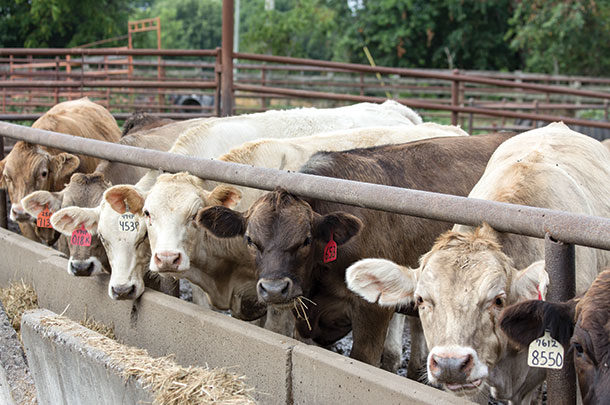The cattle industry does a very good job of talking about dollars and cents, breakevens and the bottom line. When the markets don’t work in producers’ favor, and feeder margins start to look thin or even dip into the red, every dollar that brings a return becomes crucial, and everyone in the industry begins to look for ways to become more profitable.
Producer and feeder Joe Kagay of Amity, Missouri, found that utilizing the resources of an independent feed and livestock consultant has made a positive impact on his bottom line.
“Margins have been very tight; in fact, we’ve only had the last three or four groups of cattle we’ve sold (from his feedyard) ... show a little profit in the better part of a year,” says Kagay, who farms, ranches and operates a small feedyard.
“I’ve had several nutritionists over the years, most of which worked for feed companies,” says Kagay. “I really need to have a 3-pound-a-day gain in our feedyard for the entire feeding period to remain profitable while keeping our costs of gain as low as possible.
I couldn’t do that without a good nutritionist who gets us the right feeds, for the best ration we can have, at the right price.”
What determines independent?
Kagay used nutritionists at Great Plains Livestock Consulting, which do not receive a salary from any feed company. This enables them to recommend rations, products and services that are the best option and most profitable for each of their unique clients.
Producers are free to choose from a range of recommended products and feed manufacturers that suit their requirements in terms of cost, freight, lead time, mode of action, product claims and level of quality control.
“We work with a large number of different feed mills throughout the U.S. to build the balancers or minerals that we recommend to people, but we aren’t affiliated with one specific feed company,” says Ki Fanning, a consultant and founder of Great Plains Livestock Consulting.
“There are a lot of nutritionists that will claim they are independent, but if you look behind the scenes, they’re not,” he says. “We get paid in two different ways. We either charge our clients a retainer fee or a fee within feed costs through one of the many companies we are working with. That choice is up to the producer.
“Feedyards of 5,000 head or more are better off hiring us on retainer. Producers and feedyards with fewer cattle find it cheaper to work through a feed manufacturer, which allows us to work with some smaller operations and offer our services to almost any-sized operation.”
Technology and efficiency
Not only is the beef industry faced with becoming more efficient and profitable, we also live in a market where consumer perceptions of producer practices has an increasing influence over beef demand.
Urban consumers have little concern about producers’ livelihoods and bottom lines; they want to feel good about the product they feed their families, knowing that it was raised humanely, has a decreased carbon footprint, reduced energy costs and methane production.
“Technology is changing so very quickly. The amount of information and knowledge we are gaining at this time period is so much that one person can’t be an expert in everything,” Fanning says.
“In today’s market, you have to surround yourself with a really good team of experts that help you become the most efficient, productive and best operation you can be.”
Fanning says his services aim to help producers in the long run with an average reduction in feed cost by 20 cents a head per day.
“Subtle changes can make a big difference. The most common problem with imbalanced rations is spending too much money on feed costs. But rarely does anyone see that,” he says.
“If the diet is too low in protein, feed efficiency is not going to be as good. That may not be as important as we approach $3 corn, but at $8 corn it’s very important. Also, running too high or too low a level of roughage on the finishing side is going to reduce your gain, and that can be a huge issue, especially in the time period of tight margins we’ve just gone through.”
Balancing rations
On the cow-calf side, one of the most common problems with imbalanced rations can be seen in conception rates of heifers due to overfeeding, which develops a hard-keeping cow, or underfeeding and not having them at the right body score condition to breed the second time.
“Through confined cow research, we have learned a cow will eat until she’s full rather than eat what she needs. We can feed cows a limited diet and maintain bodyweight very easily. I don’t think we’ve come to understand very well just how efficient a cow can be if she’s forced to be.
We have clients whose cows are eating 14 to 22 pounds of dry matter and maintaining or even gaining bodyweight,” says Fanning.
“So if you think about that for cows that are not in confinement, we don’t need to stick a round bale out in the pasture and let them eat all they can. We can feed them limited amounts of hay, bring in some protein such as distillers, gluten or soybean meal and a little bit of energy, whether that’s wheat, barley or corn, and have that cow extremely efficient.
By doing so, we can easily save 50 cents a head a day by limit feeding.”
Balancing rations is a small part of the services offered by Great Plains Livestock Consulting. They also help producers with increasing stocking, weaning and conception rates, bunk management, facility design, synchronization programs, manure management, health protocols, buying projections and more, providing a second set of eyes to help producers improve production and solve problems.
“I still run into a number of producers who are not using a correct implant program. Just by changing their implant program, we can increase bodyweight from 30 to 100 pounds by the time their calves are yearlings,” he says.
Of all the different animal health products on the market today, implants are still the one tool that offers the most return on investment and, on average, improves feed conversion by 7 percent.
“We see a large number of different operations in 22 states, whether it’s open yards, semi-confinement or confinement operations, which allows us to bring a lot of different perspectives to our clients,” says Fanning.











